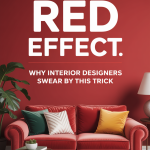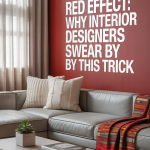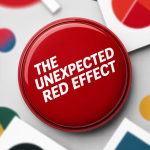The Unexpected Red Effect: Why Designers Swear By This Trick
Sharing is caring!
If you’ve scrolled through design TikTok or Instagram lately, you’ve probably run into the “Unexpected Red Theory.” At first, it sounds like just another catchy online trend, but it’s actually a principle that designers have been using for decades. The idea is simple: add a touch of red—especially somewhere you wouldn’t expect it—and suddenly the room feels more complete, more balanced, and more alive.
When I first heard about this theory, I wasn’t so sure. Red has always felt like a risky color to me. It’s strong, bold, and sometimes even overwhelming. But after playing around with it in my own home and keeping an eye on designers who do it well, I’ve become a full believer. The truth is, a little red really can change everything.
What Exactly Is the Unexpected Red Theory?
The Unexpected Red Theory is the belief that even the smallest touch of red can ground a room and make it feel finished. It’s not about drenching your walls in crimson or buying a giant cherry-red sectional. In fact, the power of the theory comes from subtlety: a frame, a throw pillow, a quirky kitchen tool, or a single piece of furniture can completely shift the mood of a space.
Red is one of the most powerful colors in the spectrum. It’s associated with energy, confidence, love, and vitality. Even when you don’t notice it consciously, your brain does. That’s why adding red in a place you wouldn’t expect it creates such a striking effect—it pulls the eye, breaks up monotony, and gives the room a sense of rhythm.
The Psychology of Red
Colors aren’t just visual—they’re emotional. Red, in particular, has a deep psychological impact. Studies have shown that the color red can increase heart rate, sharpen focus, and even stimulate appetite. This is why so many restaurants incorporate red in their branding and décor.
-
In a dining room, rich shades of red can make meals feel warmer and conversations linger longer.
-
In a home office, a red desk chair or lamp can help keep energy levels up.
-
In a living room, red accents make the space feel cozier and more welcoming.
Different shades also carry different emotional weights. A deep burgundy feels sophisticated and moody, while a bright cherry feels playful and retro. Terracotta reds lean earthy and grounding, while raspberry tones feel fresh and contemporary. Choosing the right shade for your space is part of the fun.

A Little History: Red Through the Ages
Red has been one of the most symbolic colors across cultures for centuries.
-
In ancient China, red symbolized prosperity and good fortune, which is why it still dominates weddings and celebrations.
-
In ancient Rome, red was associated with power and strength; soldiers wore red tunics into battle.
-
In early America, a red front door meant “welcome” to travelers.
-
In fashion, red lipstick, red shoes, and red dresses have long been symbols of confidence and boldness.
Designers have also leaned on red throughout history. Dorothy Draper, one of the most influential interior designers of the 20th century, famously used red in her bold, glamorous interiors. David Hicks, another legendary designer, paired reds with unexpected patterns to create unforgettable rooms. Today, the theory feels fresh again because social media has put the spotlight back on color.
Why Red Works (Even When You Think It Shouldn’t)
So why does this theory actually work in practice?
-
It creates a focal point. A small red chair in a room full of neutrals instantly gives the eye somewhere to land.
-
It balances other bolds. Red and green, when paired in muted tones, feel timeless instead of seasonal.
-
It adds warmth. Cold, modern spaces often feel more livable once a little red is added.
-
It acts like a neutral. Believe it or not, red can function like navy or black when used sparingly. It grounds the space instead of overwhelming it.
The key is that red carries more visual weight than most colors. That’s what makes it so transformative.
Easy Ways to Add Red to Your Home
You don’t need to paint your walls or buy new furniture to try this theory out. Start small.
-
A red lampshade on a neutral side table.
-
Cherry-red taper candles on your dining table.
-
A rustic red clock hanging in the kitchen.
-
A vintage floral quilt with subtle red stitching.
-
Framed red artwork or even a modern print.
-
A glossy red Dutch oven sitting on the stovetop.
One of my favorite tricks is to look for red in unexpected objects. I once found a cherry-red metal pencil sharpener at a flea market, and it’s now one of my favorite accent pieces on my desk.

Room-by-Room Red Guide
Each room has its own sweet spot for red. Here’s a closer look.
Living Room
A red lounge chair, ottoman, or accent table can give a neutral living room just the spark it needs. Even a simple red throw pillow against a green or beige sofa makes a statement.
Dining Room
This is the perfect space for red. Red is known to stimulate appetite, which makes it ideal for entertaining. Deep red wallpaper or even a set of red dining chairs can transform the atmosphere.
Kitchen
This is where red accessories shine. A kettle, mixer, or cast-iron pan adds instant cheer. If you want something bolder, try a red tile backsplash or bar stools.
Bedroom
Red in the bedroom should be used with care since it’s an energizing color. Opt for soft, muted reds in bedding or throw blankets to add warmth without disrupting sleep.
Bathroom
This is a fun place to be playful. Red towels, a red vanity stool, or even a patterned red shower curtain can make a small bathroom feel unforgettable.
Outdoor Spaces
Think bistro chairs, red planters, or lanterns. Red holds its own against natural greenery and makes patios feel vibrant.
Shopping My Favorite Red Accents
When I shop for red pieces, I keep an eye out for both modern and vintage finds. Some favorites:
-
Pooky Lighting: Rechargeable red sconces and table lamps.
-
Amazon: Budget-friendly red cookware, pitchers, and small lamps.
-
Etsy & Vintage Shops: One-of-a-kind red frames, clocks, and quirky accents.
-
Anthropologie: Playful textiles and ceramics with red details.
-
CB2: Sleek, modern red accent furniture that doubles as a statement piece.
For a budget-friendly start, I love making a “red swap”—switching out one everyday object for a red version. A red dish towel, a red vase for flowers, or a red notebook on your desk are easy first steps.
Common Mistakes to Avoid
Red is powerful, and with power comes responsibility. A few things to watch out for:
-
Don’t go too matchy-matchy. A room with red curtains, red pillows, and a red rug starts to feel overwhelming.
-
Pay attention to undertones. Orange-reds and blue-reds don’t always play nicely together.
-
Avoid overdoing it in bedrooms. Too much red can feel stimulating rather than restful.
-
Don’t ignore your existing palette. Red needs to balance with what’s already in the room.
Red by the Seasons
One of my favorite things about the Unexpected Red Theory is that it works year-round.
-
Spring: Pair cherry red accents with fresh whites and light woods.
-
Summer: Red bistro chairs or cushions pop outdoors against greenery.
-
Fall: Cranberry or brick-red throws feel cozy and seasonal.
-
Winter: Red is perfect for the holidays, but lean toward deep burgundies to keep it sophisticated.
Case Studies: Red Done Right
-
Minimalist Apartment: A stark white living room with a single red Eames chair feels elevated and curated.
-
Farmhouse Kitchen: Neutral wood tones come alive with red enamel cookware on display.
-
Eclectic Loft: A red velvet sofa layered with patterned pillows creates a playful, lived-in vibe.
-
Small Office: A plain desk setup becomes exciting with a single glossy red desk lamp.
These spaces show how versatile red can be, no matter the design style.
The Unexpected Red Theory isn’t just a trend—it’s proof of how powerful color can be. Red doesn’t have to dominate a room; it only needs to whisper in the right places. Whether it’s a lamp, a chair, or even a quirky accessory, adding red has the power to ground a space, add warmth, and make a room feel truly finished.
Next time you look around your home and feel like something is missing, try the Unexpected Red Theory. You might be surprised by how one small addition changes the entire room.



